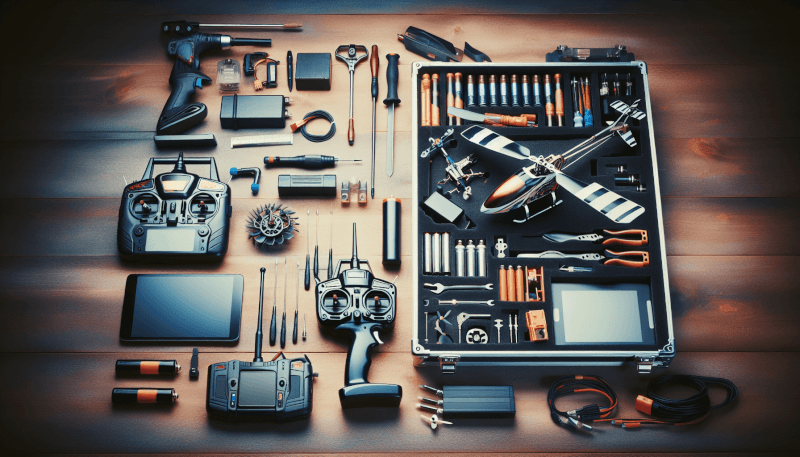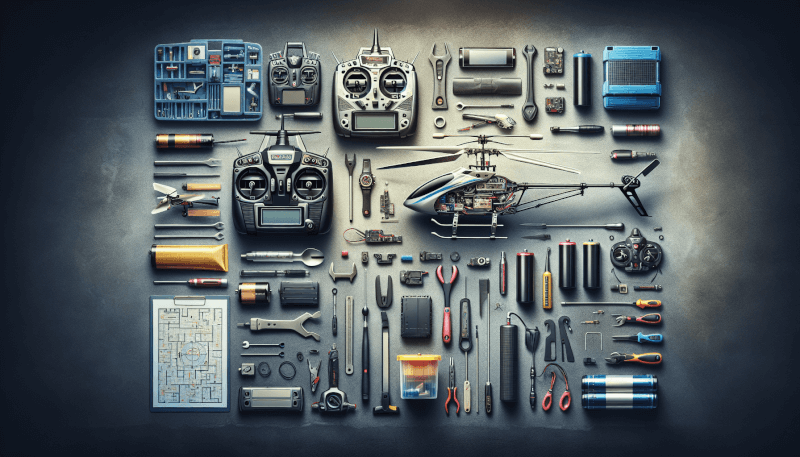So, you’ve decided to take to the skies and explore the thrilling world of remote control helicopters. But before you can embark on this exciting journey, it’s crucial to equip yourself with the necessary tools for a smooth flight. In this article, we’ll walk you through the essential equipment you’ll need as you navigate the skies with your RC helicopter. From the basics like a radio transmitter and batteries, to safety gear and spare parts, we’ve got you covered on all fronts. Get ready to soar to new heights with your RC helicopter, armed with the knowledge of the essential equipment you’ll need.
RC Helicopter
RC helicopters come in a wide variety of sizes, ranging from small indoor models to larger outdoor ones. The size of the helicopter you choose will depend on your specific preferences and where you plan to fly it. Smaller helicopters are usually more agile and can perform intricate maneuvers, while larger ones may have a greater payload capacity.
When it comes to the type of RC helicopter, you have several options to choose from. There are traditional single-rotor helicopters, coaxial helicopters with dual sets of rotors, and even quadcopters with four rotors. Each type has its own advantages and flying characteristics, so it’s important to consider your experience level and intended use before making a decision.
The control system of an RC helicopter is crucial for maneuverability and stability. Most modern helicopters use a 2.4GHz radio frequency transmitter, which provides reliable control and minimizes interference from other devices. Some helicopters also offer advanced features like GPS positioning and altitude hold, which make flying easier and more enjoyable.
Battery life is a crucial factor to consider when choosing an RC helicopter. The flight time of a helicopter can vary greatly depending on its size, type, and how aggressively you fly it. It’s important to check the manufacturer’s specifications and consider getting extra batteries if you plan to fly for extended periods.
Durability is another important aspect to consider. RC helicopters are prone to crashes and accidents, particularly for beginners. Look for helicopters made from durable materials like carbon fiber or ABS plastic, which can withstand rough landings and collisions. Additionally, some helicopters come with built-in features like crash-resistant frames and rotor guards to protect the components from damage.
Transmitter
The transmitter is what allows you to communicate with your RC helicopter and control its movements. It’s essential to choose a transmitter with enough channels to handle all the functions of your helicopter. Basic helicopters usually require at least 4 channels, while more advanced models may require 6 or more.
The frequency of the transmitter determines how far it can communicate with the helicopter. Most transmitters operate on the 2.4GHz frequency, which is widely used and provides a stable connection. Older transmitters that operate on lower frequencies may be susceptible to interference from other devices, so it’s recommended to choose a 2.4GHz transmitter.
The range of the transmitter is an important consideration, especially if you plan to fly your helicopter outdoors or in large open spaces. Higher-end transmitters often have a longer range, allowing you to fly your helicopter further away without losing control.
Ease of use is another important factor to consider when choosing a transmitter. Look for a transmitter that has an intuitive interface and comfortable controls. Some transmitters also offer features like programmable functions and LCD screens, which can enhance the user experience and make flying more convenient.
Compatibility is something you should always check before purchasing a transmitter. Make sure that the transmitter is compatible with the specific receiver in your helicopter. Some transmitters are compatible with multiple brands and models, allowing you to use them with different helicopters.

Spare Parts
Having spare parts on hand is essential for any RC helicopter enthusiast. Crashes and accidents are bound to happen, and having spare parts readily available will allow you to quickly repair your helicopter and get back in the air.
Main and tail rotors are among the most common parts that may need replacement. They are susceptible to damage during crashes or if they come into contact with obstacles. It’s important to have spare rotors of the correct size and type for your specific helicopter.
Landing gear and skids are also prone to wear and tear, especially if you frequently land on rough surfaces. Having spare landing gear and skids will ensure that you can quickly replace them if they become damaged or worn out.
Blades are another crucial spare part to have. They can become bent or damaged while flying, especially during crashes. Keeping a set of spare blades in your toolkit will ensure that you can swiftly replace them and continue flying.
The flybar is an important component of many traditional RC helicopters. It helps stabilize the helicopter during flight but is susceptible to damage if it hits the ground hard. Having a spare flybar will allow you to quickly replace it and resume flying.
The canopy of an RC helicopter is not only for aesthetic purposes but also protects the internal components. If the canopy becomes cracked or damaged, it’s important to have a spare one so you can keep your helicopter protected and looking good.
Lastly, having spare batteries is crucial. Over time, batteries can lose their capacity and become less efficient. Having spare batteries will ensure that you have enough power to fly for longer periods without interruption.
Flight Simulator
Using a flight simulator is an excellent way to practice flying RC helicopters without the risk of damaging your actual helicopter. Flight simulators use software that emulates the physics and controls of a real helicopter, allowing you to learn and improve your flying skills.
When choosing a flight simulator, it’s important to consider the software it uses. Look for simulators that have realistic physics and accurate helicopter models. Some simulators even offer advanced features like wind simulation and adjustable difficulty levels.
Compatibility is also a key factor to consider. Make sure that the flight simulator you choose is compatible with your computer operating system. Some simulators are only designed for specific platforms, so it’s important to check the system requirements before making a purchase.
Realistic controls are essential for an immersive flight simulation experience. Look for simulators that allow you to use a real RC transmitter or a dedicated flight controller. This will help you develop muscle memory and familiarize yourself with the controls of your actual helicopter.
Cost is another consideration when choosing a flight simulator. There are both free and paid options available, each with their own advantages and limitations. Free simulators are a great starting point for beginners, while paid simulators often offer more advanced features and a higher level of realism.
Training and practice are crucial aspects of becoming a skilled RC helicopter pilot. Flight simulators provide a safe and controlled environment for learning and improving your flying skills. Use the simulator to practice different maneuvers, master hovering, and develop a smooth flying style. The more you practice, the more comfortable and confident you will become when flying your actual helicopter.

Battery Charger
A reliable battery charger is essential for keeping your RC helicopter powered up and ready to fly. The right charger will ensure that your batteries are charged quickly and efficiently, minimizing downtime and maximizing your flight time.
Compatibility is a crucial factor to consider when choosing a battery charger. Make sure that the charger is compatible with the type of batteries used in your RC helicopter. Different helicopters may use different types of batteries, such as LiPo (Lithium Polymer) or NiMH (Nickel-Metal Hydride).
Charging speed is another important consideration. Look for a charger that can charge your batteries quickly without compromising their lifespan. Some chargers offer multiple charging modes, allowing you to choose between fast charging or slower, gentle charging depending on your needs.
Advanced features are worth considering if you want more control and flexibility over the charging process. Some chargers offer features like individual cell monitoring, which allows you to charge each cell (in the case of LiPo batteries) individually to ensure balanced charging. Other advanced features may include discharge and storage modes to optimize battery health.
Portability is also something to keep in mind, especially if you plan to take your RC helicopter on the go. Look for a charger that is lightweight and compact, making it easy to transport. Some chargers even offer the option to power them using a car battery or through a USB port, which can be convenient when you’re out in the field.
Tool Set
A good tool set is essential for maintaining and repairing your RC helicopter. Having the right tools readily available will make it easier to perform routine maintenance tasks and fix any issues that may arise.
A screwdriver set is a must-have tool for any RC helicopter owner. It will allow you to easily remove and tighten screws, which are used to secure various components of the helicopter. Make sure to choose a set that includes various sizes and types of screwdrivers to accommodate different screw heads.
Pliers are versatile tools that come in handy for various tasks. They can be used to grip and hold small parts, bend wires, and even cut through certain materials. Look for pliers with comfortable handles and a durable construction.
Hex wrenches are commonly used in RC helicopters, as many components use hexagonal screws. Having a set of hex wrenches in different sizes will ensure that you can easily tighten or loosen these screws when needed.
Needle-nose pliers are particularly useful for reaching into tight spaces and holding small parts. They have long, narrow jaws that can grip and maneuver small objects with precision. Look for needle-nose pliers with a comfortable grip and a smooth, non-marring finish.
A wire cutter is essential for trimming and cutting wires used in the electrical components of your RC helicopter. Look for a wire cutter that is sharp and provides clean cuts without fraying or damaging the wire.
Electrical tape is useful for insulating wires and securing them in place. It can help prevent short circuits and ensure that your helicopter’s electrical system functions properly. Make sure to have a roll of electrical tape in your tool set for quick repairs and maintenance.

Carrying Case
A sturdy and well-designed carrying case is essential for transporting your RC helicopter safely and conveniently. It protects your helicopter from damage during transport and provides organized storage for all your accessories.
When choosing a carrying case, consider the size and capacity. Make sure that the case can accommodate your helicopter, transmitter, spare parts, and other accessories. It’s important to choose a case that has enough space to store everything securely without cramming or excessive movement.
Durability is another important factor to consider. The carrying case should be made from a rugged and impact-resistant material that can withstand bumps and knocks. Look for cases with reinforced corners and a sturdy handle or shoulder strap for easy carrying.
Protective padding is crucial for keeping your helicopter and accessories safe during transport. Look for a case that has soft foam or padded compartments to securely hold your helicopter and prevent it from moving around. Additional padded dividers and compartments can also protect delicate components and accessories.
Organization is key when it comes to a carrying case. Look for a case that offers multiple compartments and pockets to easily store and access your accessories. Some cases may also have customizable dividers, allowing you to create custom configurations based on your specific needs.
FPV (First Person View) System
An FPV system allows you to experience the thrill of flying your RC helicopter as if you were inside the cockpit. It consists of various components that work together to provide a real-time video feed from the helicopter’s perspective.
The camera is the most crucial component of an FPV system. It captures the video footage and transmits it wirelessly to the receiver. Look for cameras with high-resolution capabilities and low latency to ensure a clear and smooth video feed.
The video transmitter is responsible for sending the video signal from the camera to the receiver. Look for transmitters with a good transmission range and multiple power output options. Higher power output will increase the range but may also drain the helicopter’s battery faster.
The receiver is what captures the video signal from the transmitter and displays it on a screen or goggles. Choose a receiver that is compatible with the video transmitter and offers a clear and stable reception. Some receivers also have built-in DVR (Digital Video Recorder) capabilities, allowing you to record your flights.
The display unit is where you see the live video feed from the helicopter. It can be a separate screen, goggles, or even a smartphone or tablet. Consider your personal preferences and flying style when choosing a display unit. Goggles offer an immersive experience, while screens provide a larger and more comfortable viewing area.
The antenna is a crucial component for a reliable video transmission. Look for antennas that offer a good range and have a high gain to improve signal strength. Some FPV systems allow for the use of diversity antennas, which provide better reception by using multiple antennas simultaneously.
Range is an important consideration when choosing an FPV system. The range will depend on various factors, including the transmitter power output, the quality of the antennas, and the surroundings in which you’ll be flying. Make sure to choose an FPV system that offers a range suitable for your intended flight scenarios.
Resolution is another important factor for a clear and immersive FPV experience. Look for systems that offer high-resolution video feeds to ensure that you can see details and obstacles clearly. Higher resolutions may require more bandwidth and processing power, so consider your equipment’s capabilities and limitations.

Safety Equipment
Flying RC helicopters can be an exciting and rewarding hobby, but it’s important to prioritize safety. Having the right safety equipment will protect you and others around you while you enjoy your flights.
Gloves can provide protection for your hands during flight operations. They can help prevent blisters and provide a better grip on the transmitter. Look for gloves that are comfortable, breathable, and offer good dexterity for precise control.
Goggles are essential for protecting your eyes during FPV flights. They shield your eyes from sunlight, wind, and debris, ensuring a clear and unobstructed view. Look for goggles that are comfortable to wear, have good ventilation, and can accommodate prescription glasses if needed.
A helmet is an extra layer of protection for your head during flight operations, particularly in more challenging outdoor environments. Look for a helmet that is lightweight, comfortable, and meets the necessary safety standards. Some helmets even have built-in communication systems or mounting options for cameras and lights.
Protective clothing, such as long-sleeved shirts and pants, can provide a barrier between your skin and any potential hazards. They can help reduce the risk of cuts, scratches, and sunburn. Choose lightweight and breathable materials for comfort during flights.
A fire extinguisher is an important safety precaution to have nearby when operating RC helicopters, especially if you fly in areas where wildfires are a concern. Look for a fire extinguisher that is lightweight and rated for electrical fires. Make sure to familiarize yourself with its operation and keep it accessible in case of emergencies.
Training Gear
Training gear is designed to help beginners learn how to fly RC helicopters safely and confidently. It provides additional stability and cushioning, making it easier to control the helicopter and reducing the risk of crashes and damage.
A landing gear set is one of the most common types of training gear. It adds extra support and stability to the helicopter during takeoff and landing, making it easier to maintain balance and preventing tipping or skidding.
Training skids are another type of training gear commonly used by beginners. They attach to the landing gear and provide additional surface area, making it easier to maintain stability during flights. Training skids also help protect the helicopter’s main body from damage during rough landings or crashes.
Training balls are small attachments that can be added to the rotor blades of the helicopter. They increase the moment of inertia, making the helicopter more stable and reducing the sensitivity to control inputs. Training balls are particularly useful for beginners who are still getting used to the controls and need extra stability and forgiveness.
A flybar rod is a training aid specifically designed for traditional single-rotor helicopters. It replaces the flybar and adds additional weight, helping to stabilize the helicopter during flight. Flybar rods are beneficial for beginners as they reduce the risk of overcorrecting movements and provide a more forgiving flying experience.
Flying RC helicopters can be a thrilling and rewarding hobby, but it’s important to invest in the right equipment to ensure a safe and enjoyable experience. From choosing the right helicopter and transmitter to having spare parts and safety gear, each piece of equipment plays a vital role in your RC helicopter journey. Take the time to research and weigh your options to find the best equipment that suits your needs and skill level. With the right equipment in hand, you’ll be ready to soar through the skies and experience the joy of flying an RC helicopter.



